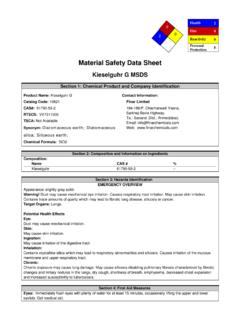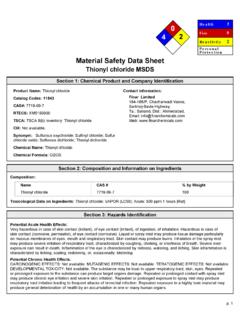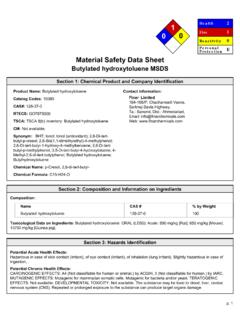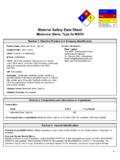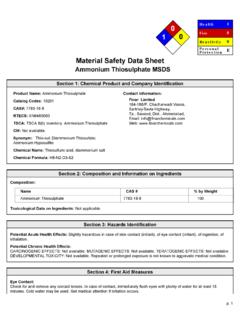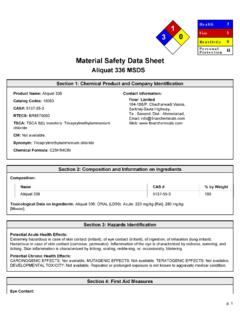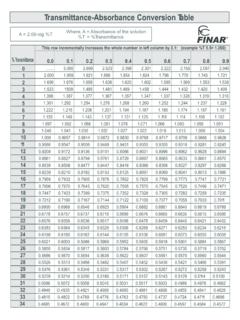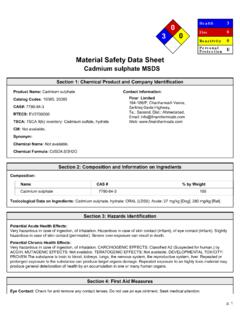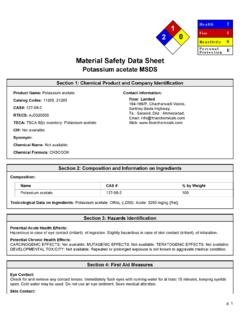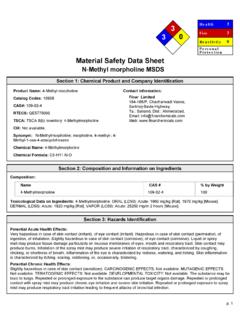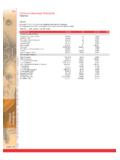Transcription of Material Safety Data Sheet - finarchemicals.com
1 P. 1 0 2 0He a lt hFireRe a c t iv it yP e rs o n a lP ro t e c t io n200 EMaterial Safety data Sheet Molybdic acid hydrate MSDSS ection 1: Chemical Product and Company IdentificationProduct Name: Molybdic acid hydrateCatalog Codes: 10990, 20990 CAS#: 7782-91-4 RTECS: Not : TSCA 8(b) inventory: Molybdic acidCI#: Not : Chemical Name: Molybdic acidChemical Formula: H2 MoO4 Contact Information:Finar Limited184-186/P, Chacharwadi Vasna, Sarkhej-Bavla Highway, Ta.: Sanand, Dist.: Ahmedabad, Email: Web: 2: Composition and Information on IngredientsComposition:NameCAS #% by WeightMolybdic acid hydrate7782-91-4100 Toxicological data on Ingredients: Molybdic acid LD50: Not available. LC50: Not 3: Hazards IdentificationPotential Acute Health Effects: Hazardous in case of skin contact (irritant, permeator), of eye contact (irritant), of ingestion,of Chronic Health Effects:Hazardous in case of skin contact (irritant, permeator), of eye contact (irritant), of ingestion, of inhalation.
2 CARCINOGENICEFFECTS: Not available. MUTAGENIC EFFECTS: Not available. TERATOGENIC EFFECTS: Not TOXICITY: Not available. The substance is toxic to lungs, mucous membranes. Repeated or prolongedexposure to the substance can produce target organs 4: First Aid MeasuresEye Contact:Check for and remove any contact lenses. Immediately flush eyes with running water for at least 15 minutes, keeping eyelidsopen. Cold water may be used. Do not use an eye ointment. Seek medical 2 Skin Contact:After contact with skin, wash immediately with plenty of water. Gently and thoroughly wash the contaminated skin with runningwater and non-abrasive soap. Be particularly careful to clean folds, crevices, creases and groin. Cover the irritated skin with anemollient. If irritation persists, seek medical Skin Contact:Wash with a disinfectant soap and cover the contaminated skin with an anti-bacterial cream.
3 Seek medical : Allow the victim to rest in a well ventilated area. Seek immediate medical Inhalation: Not :Do not induce vomiting. Loosen tight clothing such as a collar, tie, belt or waistband. If the victim is not breathing, performmouth-to-mouth resuscitation. Seek immediate medical Ingestion: Not 5: Fire and Explosion DataFlammability of the Product: Temperature: Not Points: Not Limits: Not of Combustion: Not Hazards in Presence of Various Substances: Not Hazards in Presence of Various Substances:Risks of explosion of the product in presence of mechanical impact: Not available. Risks of explosion of the product inpresence of static discharge: Not Fighting Media and Instructions: Not Remarks on Fire Hazards: Not Remarks on Explosion Hazards: Not 6: Accidental Release MeasuresSmall Spill:Use appropriate tools to put the spilled solid in a convenient waste disposal container.
4 If necessary: Neutralize the residuewith a dilute solution of sodium carbonate. Finish cleaning by spreading water on the contaminated surface and dispose ofaccording to local and regional authority Spill:Use a shovel to put the Material into a convenient waste disposal container. Neutralize the residue with a dilute solution ofsodium carbonate. Finish cleaning by spreading water on the contaminated surface and allow to evacuate through the sanitarysystem. Be careful that the product is not present at a concentration level above TLV. Check TLV on the MSDS and with 7: Handling and StoragePrecautions:Do not breathe dust. Wear suitable protective clothing In case of insufficient ventilation, wear suitable respiratory equipment Ifyou feel unwell, seek medical attention and show the label when possible. Avoid contact with skin and eyes Keep away fromincompatibles such as oxidizing agents, 3 Storage:No specific storage is required.
5 Use shelves or cabinets sturdy enough to bear the weight of the chemicals. Be sure that it isnot necessary to strain to reach materials, and that shelves are not 8: Exposure Controls/Personal ProtectionEngineering Controls:Use process enclosures, local exhaust ventilation, or other engineering controls to keep airborne levels below recommendedexposure limits. If user operations generate dust, fume or mist, use ventilation to keep exposure to airborne contaminantsbelow the exposure Protection:Splash goggles. Lab coat. Dust respirator. Be sure to use an approved/certified respirator or equivalent. Protection in Case of a Large Spill:Splash goggles. Full suit. Dust respirator. Boots. Gloves. A self contained breathing apparatus should be used to avoidinhalation of the product. Suggested protective clothing might not be sufficient; consult a specialist BEFORE handling Limits:TWA: 5 (mg/m3) from ACGIH Consult local authorities for acceptable exposure 9: Physical and Chemical PropertiesPhysical state and appearance: Solid.
6 (Crystalline solid.)Odor: Not : Not Weight: g/moleColor: (1% soln/water): 4 [Acidic.]Boiling Point: Point: 70 C (158 F)Critical Temperature: Not Gravity: (Water = 1)Vapor Pressure: Not Density: Not : Not Threshold: Not Dist. Coeff.: Not (in Water): Not Properties: Not : Very slightly soluble in cold water, hot 10: Stability and Reactivity DataStability: The product is 4 Instability Temperature: Not of Instability: Not with various substances: Reactive with oxidizing agents, : Non-corrosive in presence of Remarks on Reactivity: Not Remarks on Corrosivity: Not : 11: Toxicological InformationRoutes of Entry: Dermal contact. Eye contact. Inhalation. to Animals:LD50: Not available. LC50: Not Effects on Humans: The substance is toxic to lungs, mucous Toxic Effects on Humans: Hazardous in case of skin contact (irritant, permeator), of ingestion, of Remarks on Toxicity to Animals: Not Remarks on Chronic Effects on Humans: To the best of our knowledge, the toxicological properties of thissubstance have not been thoroughly Remarks on other Toxic Effects on Humans: Material is irritating to mucous membranes and upper 12: Ecological InformationEcotoxicity: Not and COD: Not of Biodegradation:Possibly hazardous short term degradation products are not likely.
7 However, long term degradation products may of the Products of Biodegradation: The products of degradation are more Remarks on the Products of Biodegradation: Not 13: Disposal ConsiderationsWaste Disposal:Section 14: Transport InformationDOT Classification: Not a DOT controlled Material (United States).Identification: Not Provisions for Transport: Not 15: Other Regulatory Informationp. 5 Federal and State Regulations: TSCA 8(b) inventory: Molybdic acidOther Regulations: OSHA: Hazardous by definition of Hazard Communication Standard (29 CFR ).Other Classifications:WHMIS (Canada): CLASS D-2A: Material causing other toxic effects (VERY TOXIC).DSCL (EEC): R36/38- Irritating to eyes and ( ):Health Hazard: 2 Fire Hazard: 0 Reactivity: 0 Personal Protection: ENational Fire Protection Association ( ):Health: 2 Flammability: 0 Reactivity: 0 Specific hazard:Protective Equipment:Gloves.
8 Lab coat. Dust respirator. Be sure to use an approved/certified respirator or equivalent. Wear appropriate respiratorwhen ventilation is inadequate. Splash 16: Other InformationReferences:- Material Safety data Sheet emitted by: la Commission de la Sant et de la S curit du Travail du Qu bec. -The Sigma-Aldrich Library of Chemical Safety data , Edition II. -Hawley, The Condensed Chemical Dictionary, 11e ed., New , Van Nostrand Reinold, Special Considerations: Not : 10/06/2010 Last Updated: 27/11/2012 The information above is believed to be accurate and represents the best information currently available to us. However, wemake no warranty of merchantability or any other warranty, express or implied, with respect to such information, and we assumeno liability resulting from its use. Users should make their own investigations to determine the suitability of the information fortheir particular purposes.
9 In no event shall Finar Limited be liable for any claims, losses, or damages of any third party or for lost profits or any special, indirect, incidental, consequential or exemplary damages, howsoever arising, even if Finar Limited has been advised of the possibility of such damages.
